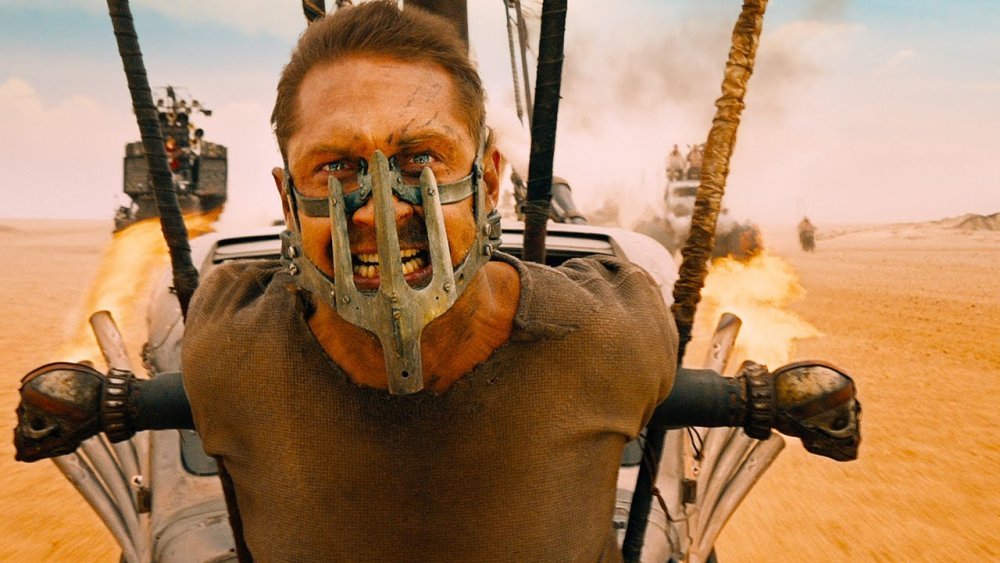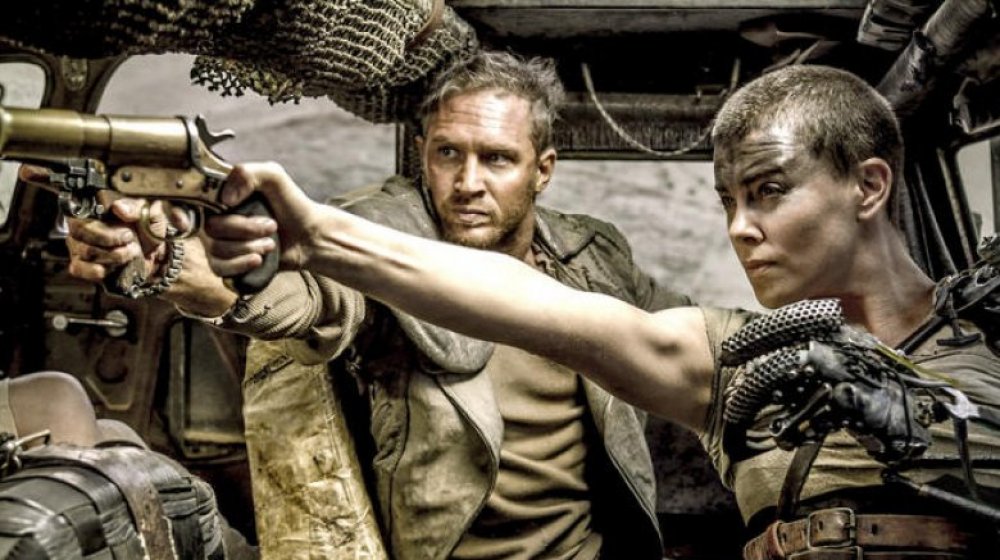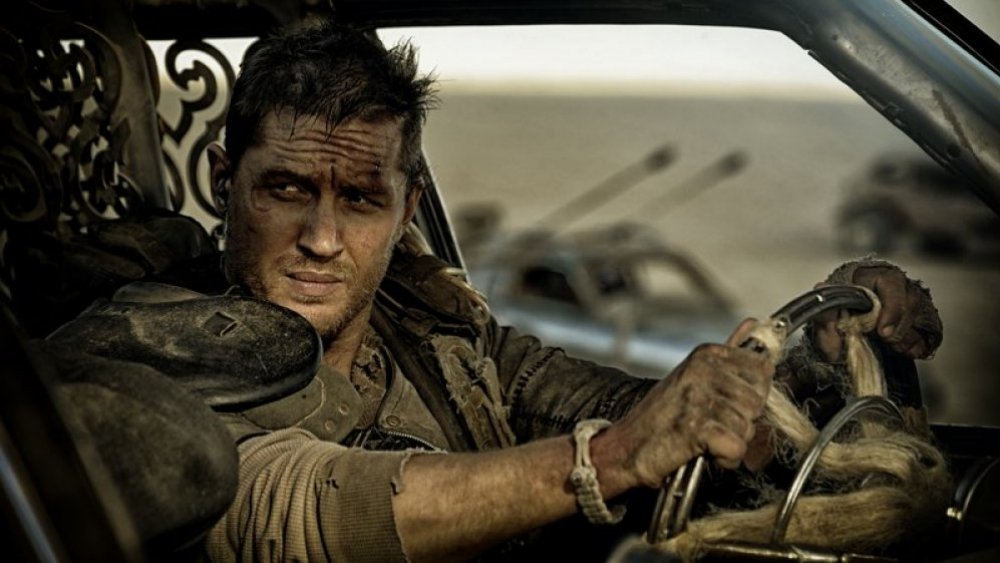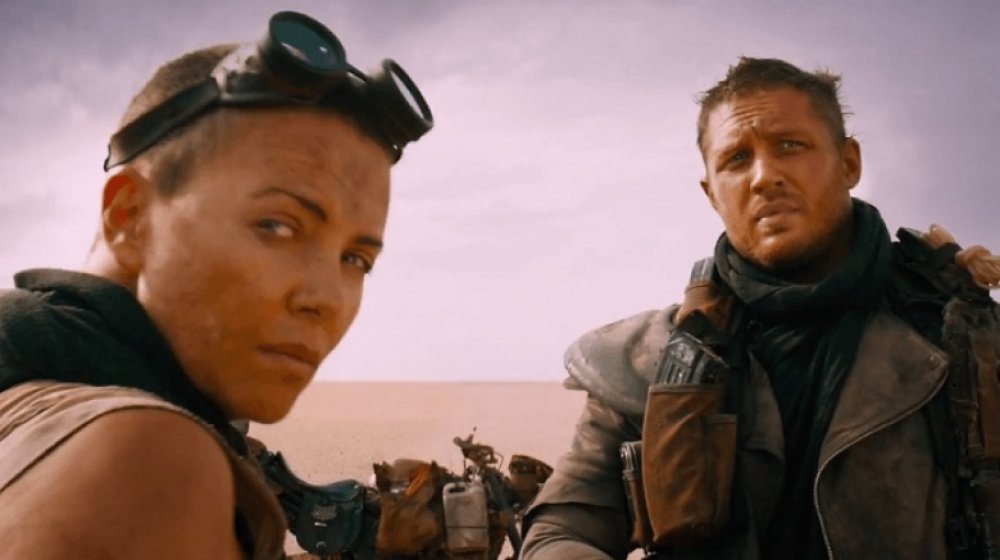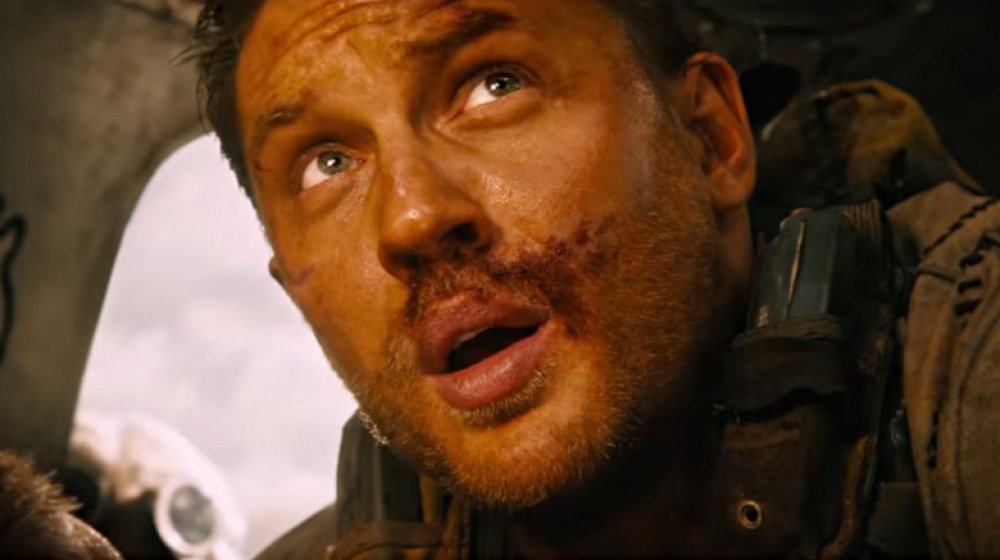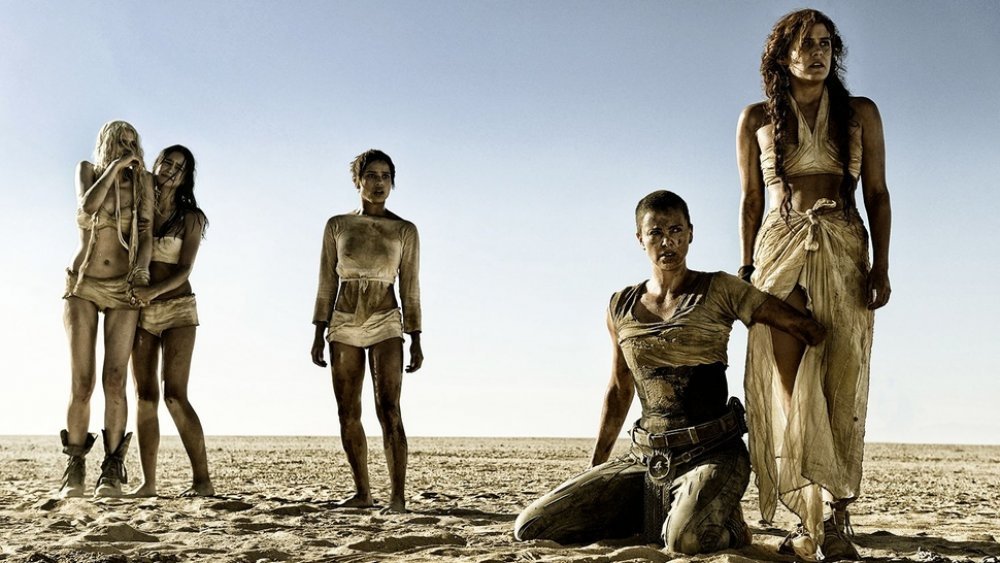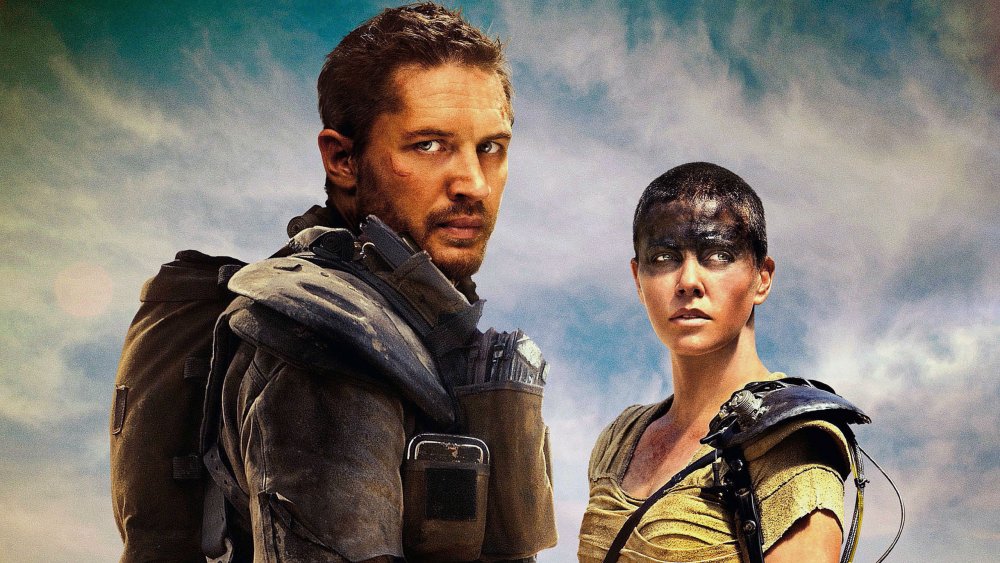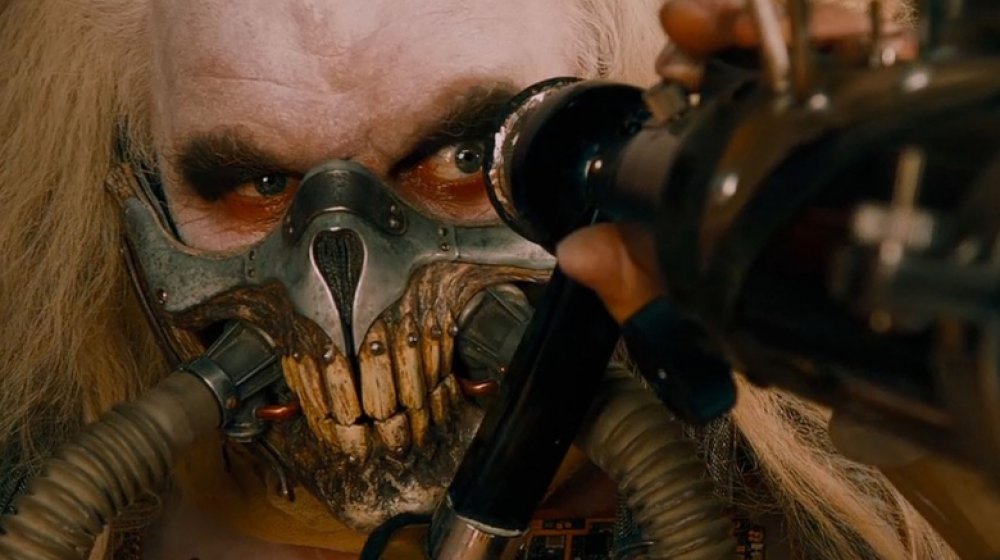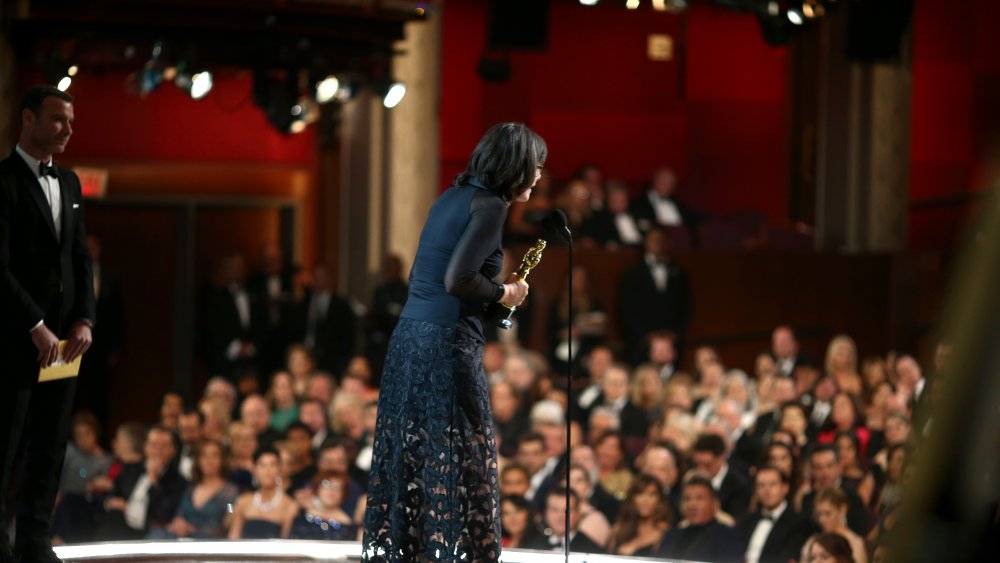The Truth About Mad Max: Fury Road's Behind-The-Scenes Troubles
Making sequels years after the original film's release isn't always a great idea but, luckily, George Miller's long-awaited fourth Mad Max film, released decades after the originals, proved to be the exception to the rule. When Mad Max: Fury Road hit theaters in 2015, it took the world by storm, winning over critics and audiences, alike, and earning an excellent pull at the box office. Ultimately, it won the most Oscars of any nominated film during the 2016 ceremony, taking six out of its ten nominations in technical categories, and scoring a nod for Best Picture.
Tom Hardy plays Max Rockatansky, who teams up with Imperator Furiosa (Charlize Theron) to evade cult leader Immortan Joe (Hugh Keays-Byrne) and his army of War Boys. Along with Furiosa, Max travels with Immortan Joe's group of captive wives used for breeding – Toast the Knowing (Zoë Kravitz), Capable (Riley Keogh), The Dag (Abbey Lee), Cheedo the Fragile (Courtney Eaton), and The Splendid Angharad (Rosie Huntington-Whiteley) – as they try to reach the Citadel, which has some of the only remaining resources in this apocalypse-stricken world.
As difficult as Max and Furiosa's journey is throughout this thrilling action-packed film, the movie, itself, underwent a difficult road of its own. Here are some of the juiciest tidbits and troubles that went on behind the scenes in Mad Max: Fury Road, according to a new tell-all oral history published in the New York Times.
Making Mad Max: Fury Road was a difficult process
If you immediately got the feeling that Mad Max: Fury Road was difficult to make just from watching the movie, you're not alone. Other filmmakers quoted in the oral history, including Oscar winner Bong Joon-ho and Steven Soderbergh, commented on the obvious difficulties involving in making the film. Bong said that the movie's sheer scale "brought him to tears," and, in 2017, Soderbergh told The Hollywood Reporter, "I don't understand how they're not still shooting that film, and I don't understand how hundreds of people aren't dead."
Everybody involved with Fury Road confirmed these feelings, especially the film's stars. Theron told the Times, "Like anything that has some worth to it, it comes with complicated feelings. I feel a mixture of extreme joy that we achieved what we did, and I also get a little bit of a hole in my stomach. There's a level of 'the body remembers' trauma related to the shooting of this film that's still there for me." Keogh, similarly, said, ""It was one of the wildest, most intense experiences of my life," while Huntington-Whiteley added, "You could have made another movie on the making of it."
Tom Hardy, who rarely minces words about his on-set experiences, simply said, "It left me irrevocably changed." The difficulties, however, actually started years before the actors even arrived on set, as the project was actually delayed for over a decade.
Fury Road's journey started in the late 1990s
Despite the fact that Fury Road didn't come out until 2015, its creative team started working on the project in 1998, and, after several years in development, the shoot was scheduled to begin in March of 2003. This required plenty of equipment and sets, as well as Mel Gibson, who would return as Max. As they began building, an international crisis caused major delays.
Miller recalled, "Then 9/11 happened, and everything changed. We couldn't get insured, we couldn't get our vehicles transported. It just collapsed." Production designer Colin Gibson said, "I was in Namibia in 2003 when I got the call to stop spending money. I don't know whether [the studio] decided to reroute their money back to the Iraq war, or if it was the email I got from Mel Gibson's wife asking me how many Muslims there may or may not be in Namibia and, therefore, how interested she may or may not be in the whole family coming to visit."
Ultimately, production was halted, and Miller pivoted to directing Happy Feet, a 2006 animated feature about dancing penguins (which, obviously, was a pretty huge shift in tone from Fury Road). The film performed well at the box office and, once again, Miller got the go-ahead for Fury Road ... but there was one problem: Mel Gibson. After a string of public scandals and several years, Gibson was too old and too unpopular to star in the film, and Miller was left stranded without a leading man.
A new Max and a new start
Thankfully, Miller and his team found their star before too long in Hardy. As Miller remembered, "I had the same feeling about Tom that I had when Mel Gibson first walked into the room: There was a kind of edgy charm, the charisma of animals. You don't know what's going on in their inner depths, and yet they're enormously attractive." With a new star on board, production could finally get started in Broken Hill, Australia, a desert mining town where Miller had filmed a few previous Mad Max films.
After the entire cast arrived in Australia, the film was hit with yet another unexpected problem: Rain. As producer Doug Mitchell put it, "During preproduction, the weather pattern changed in Australia and it rained and rained in Queensland, the sort of weather that happens once in a century." Colin Gibson added, "Slowly, what was desert turned into beautiful flowers. So we put everything into storage and slunk away yet again."
Both the cast and crew felt defeated and devastated. Keogh recalled, "It was the first time I had experienced a big push on a film, and I was heartbroken. I was like, 'Is it really because of the weather? Am I fired?'" Mitchell summed up the hopelessness of the entire production, saying, "We were basically defeated. How do we move on?"
Miller wanted to wait and see if the rain would stop, saying, "I said, 'Let's wait a year and see if it all dries up.' And when we saw that it wouldn't, I decided we should to go back to Namibia, where it never rains." After yet another false start, the entire production moved to Africa and tried to begin once again.
Mad Max: Fury Road production turned out to be an ordeal
With the production safely ensconced in Namibia, filming actually began, but the cast had no idea that they were in for the most intense experience of their lives. According to Kravitz, it was lucky that many of the stars, especially the wives, lacked experience. "There was something really beautiful about how inexperienced a lot of us were — we were so down for the cause," she said. "I don't know what it would be like if you had five actresses who'd been working for a long time that would call their agents and be like, 'What the hell is going on here?'" Meanwhile, Huntingon-Whiteley, who is engaged to action star Jason Statham, remembered telling him about her experiences on set, only for him to respond, "'Wow, this is so different from how I've ever gone to work.'"
As it turns out, the creative team set out to make the experience as challenging as possible. Gibson admitted, "All the action had to be real. The hair can't stand up on the back of your neck — not for me, anyway — watching Vin Diesel drag a three-ton safe down through perfect right-angle turns on the street. The whole rationale was to make it as real as possible so that as much as possible was at stake."
Despite the danger, Hardy knows that everybody was ultimately taken care of, saying, "As we dug in, it was dangerous, or certainly could have been extremely so, if it weren't for the methodical professionalism and preparation of the experts: stunt coordination, stunt team and riggers."
Working conditions on Mad Max: Fury Road were extremely difficult
After escaping rain in Australia, the production continued to be plagued by weather problems. Though the elements didn't stop the production, they definitely made for a difficult time on set. Theron later admitted, "The biggest thing that was driving that entire production was fear. I was incredibly scared, because I'd never done anything like it. I think the hardest thing between me and George is that he had the movie in his head and I was so desperate to understand it."
With challenges that included wind, sand, and extreme temperatures, the cast certainly suffered, to a degree. Lee said, "It looks warm, but we shot it in the winter and it was blisteringly freezing. Us girls weren't wearing much, and Riley got hypothermia." Keogh added, "There were night shoots that were brutal, and there was so much dust that your face would be covered with three inches of sand by the end of the day. We kept it together pretty well, I think, for the first five months." Kravitz, however, was much more blunt, saying, "By the end, we wanted to go home so badly. It had been nine months, and not nine months where you're in a city and you hang out in your trailer. It was nine months of the environment you're seeing in the movie, with nothing around. You really do start to lose your mind a little bit."
Miller, in the film's aftermath, is realistic about how difficult it became. "There was a high degree of difficulty on the film, and unless you are entirely rigorous about safety, something is inevitably going to go wrong," he said. "I guess the actual working process of the actors, I probably should have paid more attention to."
Tensions ran rampant on the Mad Max: Fury Road set
Meanwhile, a now-infamous feud was brewing between Fury Road's two biggest stars, Theron and Hardy. Hardy struggled with the slapdash nature of the shoot, and Charlize trusted Miller, which led to frustrations between the two of them.
For his part, Hardy has some regrets. "I think in hindsight, I was in over my head in many ways," he said. "The pressure on both of us was overwhelming at times. What she needed was a better, perhaps more experienced, partner in me. That's something that can't be faked. I'd like to think that now that I'm older and uglier, I could rise to that occasion." Theron agreed, saying, "In retrospect, I didn't have enough empathy to really, truly understand what he must have felt like to step into Mel Gibson's shoes. That is frightening! And I think because of my own fear, we were putting up walls to protect ourselves instead of saying to each other, 'This is scary for you, and it's scary for me, too. Let's be nice to each other.' In a weird way, we were functioning like our characters: Everything was about survival."
Lee, however, thinks it was good for the movie, saying, "The grueling nature of the shoot really served it, in my opinion. The characters are supposed to be exhausted, they're supposed to be searching for strength. I just don't think that any of the performances would have been the same had it all been green-screen and we did it in a controlled environment. The fact that it was a huge mess is why it's so brilliant."
One final Mad Max: Fury Road hurdle
Thanks to the enormous difficulty involved with the process, Fury Road still had one big hurdle left in its path: The studio. Thanks to the huge budget and over-long filming process, then-president of Warner Bros. Jeff Robinov flew to Namibia to check on the progress and didn't like what he found. As cinematographer John Seale said, he had a "gold-plated fit."
Mitchell recalled, "He said, 'The camera will stop on Dec. 8, no matter what you've got, and that's the end of it.' We hadn't shot any of the scenes in the Citadel yet, where the opening and closing book ends of the film are set, and we had to go into postproduction without them. It was almost incomprehensible."
Editor Margaret Sixel — Miller's wife, who won an Oscar for editing the film — was left with an impossible task of finishing a film without an ending. As she remembered, "It was really difficult to spend that year cutting a film that didn't have an opening or closing. I kept thinking, 'How am I going to make this work? Are we going to write voice-over and try to fill in all the gaps during the opening chase?'"
Luckily, fate intervened, according to Mitchell. "What happened then is that Jeff lost his job and Kevin Tsujihara was appointed, and he decided later that year, 'You know what, let's do this properly. We need to shoot these scenes at the Citadel.' So we brought back all these vehicles from Namibia, reassembled the team in late 2013, and brought Tom and Charlize to Australia. It could have been completely different, had the gods not been shining down."
Life after Fury Road
Not only did Miller, Sixel, and the rest of the cast and crew finish the film, but it premiered at Cannes in 2015 to immediate acclaim. Despite the difficulties involved, everyone who was a part of the production remains proud of it. As Kravitz put it, "As an actor, you make a lot of movies — some of them are good and some of them are bad, and you have to kind of let that go. But with this one, it really felt like we put our actual blood, sweat, tears and time into it, and if it hadn't been good, I would have been devastated. It was one of the hardest things I've ever done in my life, but it was absolutely worth it, and I would do it again if George asked me to."
Sixel agreed, saying, "When we actually finished the film and it was a success, that was the best year we ever had. We'd repeat the stories of making the film to each other over and over again: How did we get to the other side? We still kind of marvel at it." Mitchell still can't believe how successful the film was either, saying, "What an extraordinary experience to have a film that was so difficult, that may never have been made, and at the end of the day it wins Academy Awards and is called one of the best films of the decade."
If you want to relive the glory that is Mad Max: Fury Road, problems and all, you can rent the film on several different streaming platforms today.
